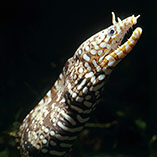| Family: |
Muraenidae (Moray eels), subfamily: Muraeninae |
| Max. size: |
92 cm TL (male/unsexed) |
| Environment: |
reef-associated; marine; depth range 5 - 60 m |
| Distribution: |
Indo-Pacific: Reunion to the Hawaiian, Line and Society islands, north to southern Japan (Ref. 559) and southern Korea, south to New Caledonia. |
| Diagnosis: |
Vertebrae: 119-126. Description: Characterized by brown to brownish orange with narrow irregular dark brown bars on body, numerous dark-edged white spots, small black spots on head and body; body depth at gill opening 10-16 in TL; dorsal fin anterior to gill opening; anus anterior to middle of body; combined head and trunk (preanal length) 2.1-2.3 in TL; slender and hooked jaws; visible long canine teeth in gap between jaws when mouth closed and viewed laterally; two rows of jaw teeth; small and sharp outer row teeth, close to canines of inner row; median row at front of upper jaw with three elongate canines; elongate and tubular anterior nostril; posterior nostril a very long tube above front of eye (Ref. 90102). |
| Biology: |
Inhabits coral and rocky reefs. Common in warm-temperate waters (Ref. 9710). Benthic at 1-35 m (Ref. 58302). Feeds on fishes (Ref. 9710). Minimum depth reported taken from Ref. 86942. |
| IUCN Red List Status: |
Least Concern (LC); Date assessed: 16 August 2011 Ref. (130435)
|
| Threat to humans: |
harmless |
Source and more info: www.fishbase.org. For personal, classroom, and other internal use only. Not for publication.

